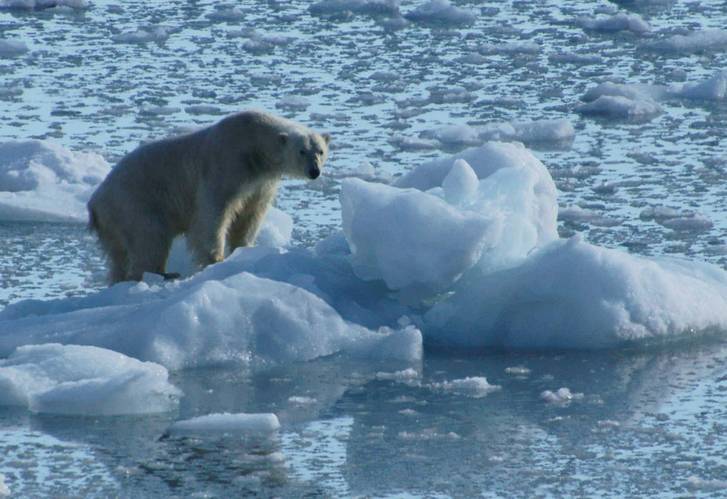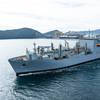North Pole: The Latest Tourist Trap
On August 16, 2015, the geographic North Pole was visited by a Russian surface ship for the one-hundredth time. The Russian nuclear icebreaker 50 Let Pobedy (50 Years of Victory) carried 106 tourists from 16 different countries. This was the icebreaker’s seventh cruise to the Pole just this season. Each voyage takes just less than two weeks round trip, and that includes a full day of partying at the top of the world. This is all available for a starting cost of $26,995 per person for a basic two-person cabin with a standard twin bed, but does not include the $1,750 round trip air fare between Helsinki and Murmansk or the cost of getting from wherever you are to and from Helsinki.
Along the way, passengers may see polar bears, seals, walrus and whales. But one should not expect to see animals at the North Pole, other than occasional fish and sea birds. Upon arrival at (or near, depending upon ice conditions) the North Pole, passengers may climb down onto the ice, drink champagne toasts, enjoy a barbeque and form a circle around the Pole (or a facsimile thereof). For added fees, passengers may take helicopter rides or, weather permitting, ride in a hot-air balloon. One should not expect to see the iconic red and white diagonally striped pole – Santa Claus took it with him when he vacated the area some years ago as the locale started to attract attention.
Then, it is back onboard for a dash back to Murmansk, possibly with a short diversion for sight-seeing in Franz Josef Land. This uninhabited archipelago was discovered in 1873 by the Austro-Hungarian North Pole Expedition, who named it for their Emperor. In addition to the sea birds, polar bears, seals, walrus and whales, Franz Josef Land also supports a population of Arctic fox.
The North Pole (or Geographic North Pole, to distinguish it from the Magnetic North Pole) is where the rotational axis of the Earth reaches the surface of the Earth in the Northern Hemisphere. While it is theoretically a fixed point, it actually moves slightly (or wobbles) because the Earth is not a perfect and uniform sphere. This wobbling is in the range of a few meters, so is only important in instances requiring very precise positioning.
The North Pole has been a quest for centuries, but was not reached by man until April 6, 1909, when Robert Peary, Matthew Henson and four Inuit men apparently arrived by dogsled. On May 9, 1926, Richard E. Byrd and Floyd Bennett apparently overflew the Pole in a Ford Tri-Motor airplane. On May 12, 1926, the airship Norge flew over the Pole on a voyage from Svalbard to Teller, Alaska, piloted by Umberto Nobile and carrying veteran polar explorers Roald Amundsen and Lincoln Ellsworth.
The nuclear submarine USS Nautilus (SSN 571) became the first watercraft to reach the North Pole when it surfaced through the ice on August 3, 1958. Various other nuclear submarines of several navies have made similar surfacings since then.
The first surface vessel to reach the North Pole was the Soviet icebreaker Arktika on 17 August 1977. There have been five visits to the North Pole by non-nuclear Russian surface ships: one by the diesel-electric icebreaker Kaptain Dranitsyn and four by the research vessel Akademik Fedorov, including its 2007 trip (Arktika 2007) when, escorted by the nuclear icebreaker Rossiya, it used a manned submersible to place a titanium tube containing a Russian flag on the seafloor at the North Pole.
Russian (and Soviet) nuclear icebreakers have now visited the North Pole ninety-five times. The vast majority of those visits have been with paying passengers on board. The first such North Pole cruise was by the icebreaker Rossiya on August 8, 1990. The nuclear icebreaker Yamal has made 48 such voyages, the most by any individual surface ship, while 50 Let Pobedy has been to the Pole 33 times, and counting.
According to various sources, surface ships from other nations have traveled to the North Pole a total of 19 times. Swedish vessels have made eight trips. German vessels have made four trips. Canadian vessels have made three trips. U.S. vessels have made four trips. The icebreakers Oden (Sweden) and Polarstern (Germany) were the first non-nuclear ships to reach the North Pole, doing so on September 7, 1991. The USCGC Polar Sea and CCGS Louis S. St-Laurent reached the North Pole on August 22, 1994 and were joined the next day by the Russian nuclear icebreaker Yamal for the first three-ship rendezvous. The USCGC Healy and the Polarstern reached the North Pole together on September 6, 2001. The Russian nuclear icebreaker Sovietskiy Soyuz and the Swedish icebreakers Oden and Vidar Viking stopped at the North Pole on September 6-7, 2004 during the Integrated Arctic Ocean Drilling Program. The Canadian Coast Guard Ships Louis S. St-Laurent and Terry Fox jointly reached the North Pole on August 27, 2014. Most recently, USCGC Healy reached the North Pole on September 5, 2015 while researching the western Arctic Ocean and its seafloor, where it was met on September7 by the German icebreaker Polarstern researching the eastern Arctic Ocean and its seafloor.
Over the years, small groups have found more innovative manners of reaching the North Pole. On April 23, 1948, three Soviet aircraft landed at the North Pole. The 24 individuals established a temporary camp and conducted two days of scientific observations before flying back to the Soviet Union. On May 3, 1952, two U.S. Air Force pilots and a scientist landed at the Pole, made some brief observations and departed. On April 19, 1968, four U.S. and Canadian adventurers completed a 48-day over-ice journey from Ellesmere Island to the North Pole on snow-mobiles. In 1969, four British nationals with the British Trans-Arctic Expedition hiked, with the aid of dog sleds and airdrops from Barrow, Alaska to Svalbard via the North Pole. Two individuals from the Transglobe Expedition 1979-1982 reached the North Pole via foot and snowmobile on August 4, 1982, becoming the first individuals to complete a circumnavigation of Earth by surface travel. On April 6, 1985, a ski-equipped twin-engine Otter aircraft flew Neil Armstrong, Sir Edmund Hillary, Steve Fossett and Patrick Morrow from Ellesmere Island to the North Pole for a quick glass of champagne. This list goes on.
All of this going to and fro at the North Pole does not include the increasing shipping activity in the Arctic Ocean generally. Cruise ships, cargo ships and the occasional recreational vessels transit the Northern Sea Route across the top of Eurasia and the Northwest Passage across the top of North America.Fishing vessels are increasingly venturing into Arctic waters. Natural resource extraction in the Arctic is growing apace – and it is not limited to oil and gas. It is getting so busy that a whale can hardly think.
Several years ago, I published a manifesto written by my good friend the Arctic fox. In that document, he encouraged all Arctic animals to take action to deter and deflect outsiders (i.e., all humans other than local natives) from further incursions into the Arctic. That effort has had limited success. Natural resource extraction efforts in the Arctic have slowed from their previous rapid pace, but still continue. Use of the Northern Sea Route this navigation season is significantly less that in recent years. But other activities, such as excursion cruises to the North Pole continue apace.
For eons, the North Pole was a mythical and mysterious place, often referred to as Thule. Now, it is just another location like Machu Picchu or Angkor Wat where people go, have their picture taken (often a selfie) and then brag to their friends.
The North Pole deserves more respect.
The Author
Dennis L. Bryant is with Maritime Regulatory Consulting, and a regular contributor to Maritime Reporter & Engineering News as well as online at MaritimeProfessional.com.
t: 1 352 692 5493
e: dennis.l.bryant@gmail.com
(As published in the October2015 edition of Maritime Reporter & Engineering News - http://magazines.marinelink.com/Magazines/MaritimeReporter)















